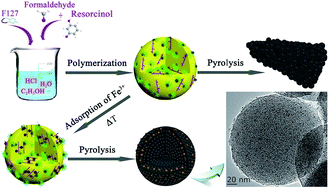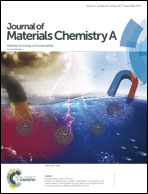Enhanced stability and metallic modification of polymeric and carbonaceous nanospheres through precursor engineering via a one-pot aqueous strategy assisted by iron ions†
Abstract
The synthesis of monodisperse mesoporous carbon nanospheres (MCNs) with diameters less than 500 nm from polymeric nanoparticle precursors remains challenging due to the spontaneous aggregation of nanospheres and the low thermal stability of polymers. Herein, a one-pot synthesis method was developed to prepare solidified polymeric nanospheres under acidic conditions, where Fe3+ ions served not only as mediators to coordinate with phenolic hydroxyl groups in linear-condensation polymer chains to form a 3D metal–organic framework-like skeleton but also as a precursor of magnetic species. The solidified structures substantially enhanced the thermal stability of polymeric frameworks and effectively mitigated the fusion of polymeric nanospheres, leading to Fe-nanoparticle incorporated MCNs with well-developed mesoporosity. Compared with the soft-template method and hydrothermal curing process, the present method integrates the low-temperature solidification and metal-incorporation processes into one procedure, which affords a convenient and energy-saving route to the synthesis of monodisperse MCNs containing functional nanoparticles. Diverse morphologies such as bulk, polyhedrons, and spheres could be easily controlled by utilizing the difference of thermal stability of polymeric nanospheres, which is closely related to the curing temperature. By optimizing the synthesis parameters, monodisperse MCNs incorporated with ultrafine Fe3O4 nanocrystals can be successfully synthesized. The resultant Fe3O4-incorporated MCNs showed a large specific surface area of 673 m2 g−1, uniform pore diameter of 3.8 nm, and high saturation magnetization strength of 24.6 emu g−1, leading to high adsorption capacity for methyl orange and methylene blue as well as rapid separation of the adsorbent via magnetic attraction. The results in the present work provide a paradigm for the preparation of functionalized MCNs through precursor engineering.



 Please wait while we load your content...
Please wait while we load your content...